Surviving is all about prioritizing your needs. There are a lot of things you need to stay alive and healthy, but you don’t need them all right now. Some things can wait a while, but others are more urgent. Ask any survival expert for the top priority and they’re going to say “emergency shelter”. Yes, you can only survive three days without water – but if you’re caught without shelter in a blizzard, or even a late fall night in the average northern forest, and you’re not going to have to worry about three days from now. Because you’re not going to be around by dawn.
Shelter always features in a prepper’s plans, whether it’s a bugout (or bugin) location, or the tent you’ll be carrying on your way to one. Life doesn’t always go to plan though. What happens if you’re away from home when a crisis hits, and have to get back there without the gear you’d expected to have? What if you’re hunting or foraging in the woods, but get lost or injured and find yourself facing a night in the open?
There are many scenarios that could see you having to improvise a shelter, so knowing how to do it is a key survival skill. In fact, if you don’t know this one the rest aren’t going to help you much.
What Kind of Emergency Shelters Should You Make?
There are a few basic shelter designs; the right one for you will depend on the environment you’re in, the weather and the materials you have to work with. They all have their advantages and disadvantages, so it’s best to know how to make them all. Here are the main emergency shelter types:
Lean To
The lean to is the simplest kind of shelter, and also one of the most versatile. It can be made from almost any materials and is easy to build in most locations. Basically, a lean to is a shelter made from a single roof panel, raised at one end and meeting the ground at the other.
When putting up a lean to, aim to have the open end downwind. That way the wind will be hitting the edge that’s in contact with the ground, and deflecting up and over the shelter. You’ll be protected from wind chill, and there will also be a bubble of relatively still air just outside the shelter. Put a fire there and it will be protected too – and its heat will be able to get in the open end of the shelter, while smoke stays outside. Build a reflector of wet logs behind the fire to get the maximum benefit from its heat.
If there’s a fence, wall or fallen tree handy it can be used to hold up the raised end of your lean-to (although this might stop you putting a fire downwind). Alternatively, you can support that end with two upright posts and, if you’re building the shelter from natural materials, a crossbar.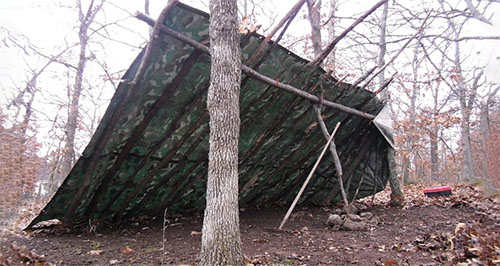
Related: 13 Shelters That You Can Build With A Military Poncho
A Frame/Tent Shape
Shelters can be built in the shape of a classic tent. This is a bit more complicated than a lean to, but it gives better protection from the elements because it’s in contact with the ground on two sides. That does a better job of keeping warm air in and the wind and rain out. For maximum protection close off one end of the shelter, leaving one open as a door. Set up tent-style shelters with the door downwind; again, you can put a reflector fire here for extra warmth.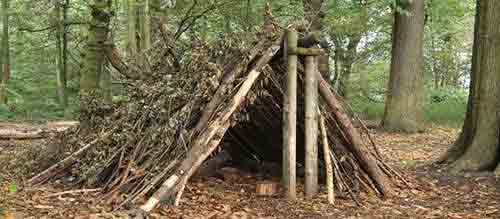 In the woods, a tent-style shelter can be supported by a line or pole between two trees. In more open ground either a single pole or an A-frame of two poles lashed together will work fine. If you’re roofing it with natural materials add a ridge pole between the uprights; look for the straightest branch or sapling you can find.
In the woods, a tent-style shelter can be supported by a line or pole between two trees. In more open ground either a single pole or an A-frame of two poles lashed together will work fine. If you’re roofing it with natural materials add a ridge pole between the uprights; look for the straightest branch or sapling you can find.
Flat Shelter
Anyone who’s been in the Army has probably spent some time under a shelter half with its corners bungeed to four trees. This is a simple but useful shelter, especially if you’re worried about rain or frost, but not wind. One of the most useful things about it is that you can set it up at any height – 18 inches off the ground if you want to sleep under it, or eight feet up to give you and your buddies a place to stand out of the rain. If you’re using a tarp or groundsheet, a flat shelter will give you the maximum protected space underneath it.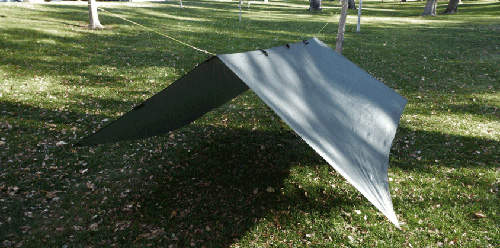 Of course, flat shelters do have disadvantages. They’re open all round, so there’s no protection from the wind. Water also tends to collect on top, and eventually its weight can bring the whole thing down. Add a slight slope if you can, and if you’re using a tarp get it stretched out as tight and flat as possible.
Of course, flat shelters do have disadvantages. They’re open all round, so there’s no protection from the wind. Water also tends to collect on top, and eventually its weight can bring the whole thing down. Add a slight slope if you can, and if you’re using a tarp get it stretched out as tight and flat as possible.
Related: 3 Quick Shelters (The Last One is Invisible!)
What Materials Can You Use to Make Your Emergency Shelter?
Unless you’re actually in the desert you can build a shelter pretty much anywhere; you just need to know how to use the materials at hand. Luckily there’s a variety of things you can make a shelter from.
Waterproof Sheets
If you’re carrying a tarp, groundsheet, shelter half or even a rain cape, you’re going to have no trouble building a shelter. These make the most waterproof roofs you can get, and they’re also very light; that means the structure of the shelter can be simpler. For example, you can make a tent-style shelter with no ridgepole; the tarp needs, at most, a length of 550 cord to support it.
Best of all, building a shelter with a waterproof sheet is fast and easy. If the weather’s gone bad in a hurry and you’re caught in it, every minute counts; minimize lost body heat and soaked gear by being able to build a shelter in five minutes rather than a couple of hours.
Scavenged Plastic
We’re a throwaway society these days, and usually that sucks. Sometimes you can be grateful for it, though. Even in rural areas there’s usually plenty plastic sheet lying around in the form of garbage. Old feed and fertilizer sacks, trash bags, even plastic bags from the grocery store – collect enough of them and they can be fixed to a lightweight frame to make a pretty watertight roof. Make the frame by lashing or weaving thin, straight branches together in a grid; plastic can then be tied to the bars of the grid. Start adding plastic from the bottom and overlap the layers, so water can’t penetrate between pieces.
Leaves
If you’ve stood under a tree in the rain you’ll know that leaves are pretty good at keeping the water off. They’ll do a good job on your shelter, too. Just don’t try tying individual leaves to the frame; you’ll be there forever.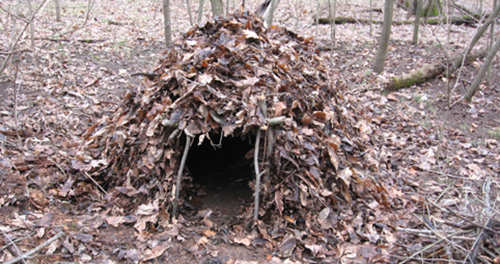 Instead, collect leafy branches. Again, start at the bottom and overlap layers. You’ll probably have to double up, as well; otherwise there will be gaps between leaves that rain and wind can get through.
Instead, collect leafy branches. Again, start at the bottom and overlap layers. You’ll probably have to double up, as well; otherwise there will be gaps between leaves that rain and wind can get through.
Related: A Small, Super Survival Shelter
Grass
Long grass is even more effective that leaves, if you get enough on your shelter and fasten it the right way. In fact, thatched roofs – layered bundles of grass or reeds – were used on houses for centuries, and there are still plenty of them keeping homes warm and dry in England and other countries. Cut long grass and make it into bunches, tie them at the cut end, then fasten them to your shelter frame with the cut ends up. Again, start at the bottom and overlap; the rain will run down the stalks rather than finding its way through, and it’ll all end up on the ground instead of on you.
Snow
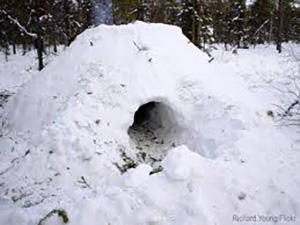 Being caught without shelter in a blizzard is one of the worst things that can happen to you – but, if you know what you’re doing, the blizzard itself will give you the materials you need to survive it. Don’t waste time trying to build an igloo, though. That’s a highly skilled job, and unless you’re an eskimo you probably don’t have the skills.
Being caught without shelter in a blizzard is one of the worst things that can happen to you – but, if you know what you’re doing, the blizzard itself will give you the materials you need to survive it. Don’t waste time trying to build an igloo, though. That’s a highly skilled job, and unless you’re an eskimo you probably don’t have the skills.
Instead, just look for a deep snowdrift and burrow into one end of it. Excavate a tunnel, then a small cave long and wide enough to lie down in – just remember that the bigger you make it, the more of your body heat will go to heating it up.
Smooth down the inside to reduce drips as snow melts, and push a stick through the roof; give that a wiggle occasionally, to keep an airhole open. You should also check the access tunnel to make sure drifting snow isn’t sealing it off. It’s easy to asphyxiate in a snow cave if you don’t keep some ventilation going. You can pack the excavated snow into rough blocks, then stack them into a wall to keep snow out of the tunnel.
If you’re in the open and there aren’t any drifts handy, resurrect your childhood snowman-making skills. Make a big snowball, then roll it along the ground until it’s as big as you can push. Make three or four more and push them all together. Pack snow into any gaps, then tunnel into the middle of the pile.
Pick the Right Neighborhood
Lastly, don’t forget to find a good site for your shelter. Spending an extra two minutes looking for the right location can make all the difference. Here are some things to look for:
- Even the best improvised shelter can take a beating in a high wind. Walls, rocks or folds in the ground can all take the worst out of the wind before it gets to you.
- Save your roof some work, and pitch your shelter under a tree canopy. Some rain will get through the leaves, but a lot less than you’d get out in the open – and it won’t be traveling as fast, either, so the water pressure will be lower. Trees tend to shed water outwards, so if you’re inside the perimeter of its canopy you’ll be protected. Just avoid old or dead trees in a high wind.
- Dips and hollows. These often look like great places to shelter. They’re not. Cold air sinks, so on a cold night being in a 15-foot-deep hollow can translate into an air temperature 5°F lower. Dips and hollows are bad in the rain, too – the bottom is likely to get soaked. If it’s a gulley you could even get caught in a flash flood. Don’t look for the high ground, but avoid the lowest spots too.
You may also like:
Woman With MS Survives in the Wild With Just a Knife and the Plants She Found (Video)
The Ultimate Bug Out Home For Just $250

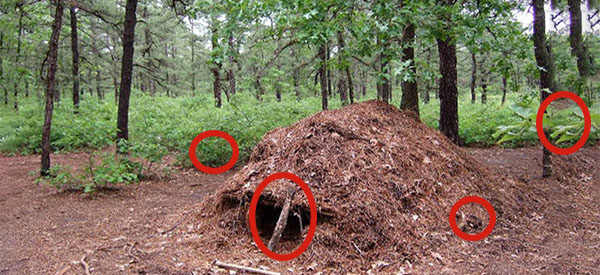














If your shelter is made in the woods, or under a lone tree, look up before you pick your shelter location. There could be dead limbs that could fall on you and cause serious injury or death. This is a “must do” in a wooded area, especially if there’s windy conditions.
Add the 5 “W’s” to Emer. Shelter Site Selection:
Wind: Find site with minimum wind impact
Water: Close water good. Avoid terrain that could flood
Widow Makers: Avoid dead overhead trees
Wood: Close wood for fire
Wigglies: Avoid insect sites such as ant hills, bees, etc.
I like that “5 W’s” concept to help remember important issues in a probably stressful situation.
You forgot high desert and desert climates where there are no trees or leaves only sagebrush and dirt! No water to speak of and no cactus to use for water!
I’m looking at a groovy pic of the Chihuahuan Desert my sweetie took on one of our hikes, it’s my desktop background and I use a 40″ TV for a monitor so I can see a lot. Ist thing, in the foreground there is what remains of a barb wire fence, looks just sturdy enough to anchor one end of a tarp, a jacket, a couple shirts, whatever you have that will give you shade for the day. The ground, sadly, is the rock and gravel called desert pavement so you can’t dig in for shelter. Fair amount of greasewood and dry grama grass for a fire. No water or food in the foreground, in the middle ground, maybe 10 miles distant, there appears to be a clump of small trees in an arroyo,some small chance of finding water there. Since the title of the article is finding shelter on the move I take it one’s safety is threatened so I wouldn’t camp there but it is worth checking out. The desert here is a basin some 20 miles wide bordered by mountains. Your eventual goal, if you don’t fall out from dehydration or heat stroke, is to get up into the drainages at the base of the mountains where you are assured of finding a spring, shelter, and a few odds and ends to eat while you starve to death because you obviously weren’t prepared. Desert survival tip: I carry a compact umbrella in my pack. It’s a funny thing to have until the time you find yourself running late with a 5 mile walk to your pickup on a 100+ afternoon, then it becomes the portable shade that saves your life.
1st tip of survival- don’t go hiking in barren places that offer little hope of survival if you get stuck hahaha
If you ever see film of street scenes in Southeast Asia, you will see lots of folk, especially women carrying parasols — an old fashioned name for umbrellas. While it is true that in many of those areas sudden summer squalls are common, the main thrust is to protect from sun —para sol latin meaning “for sun.”
My get home route would be from Tucson to Flagstaff.
I’ve always been uneasy about traveling the desert between. Too many rattlesnakes, no trees big enough to hang a hammock from. Too hot in summer to cross during daylight hours. Waterways along the way are few and far between and prone to flash floods. Desert camo clothing necessary-not dark woodsy attire. Much more gear to carry for sun protection and against heat stroke. The need to travel at night and the necessity to use heavy night vision glasses to avoid snakes and cliffs. There are so many disadvantages to traveling the desert on foot, I have carried a halter and reigns in my car with my bob with $ to purchase a horse to get home on. Even that leaves much to be desired since one would need food and water and there is little of that in Arizona. All I could do is pray that I will be close to home in a national emergency.
ShirlGirl,
If nothing works for you like getting a horse. Then travel by night along a road. Only leave the road it you see someone or hear them. Find shelter early This way you have less snakes to worry about and a smoother surface to walk on. This mean less travel time and less danger.
Why do you keep posting things you have already done?
Try these, for a change.
Sewing
Clothes making
How to skin and butcher common animals
How to trap animals
How to preserve skins
How to clear buildings
How to fortify a place you find and want to make a home out of
There’s so much to cover, why keep doing an echo chamber?
When I was a teenager, I took up as a hobby taxidermy of wild animals.
I did learn a bit about trapping animals. Became very competent at skinning and butchering.Learning how to preserve skins an absolute.
Highly recommend it! That covers 3 of your list of 7.
Trot lines, bush hooks, traps. A lot of people live near water, but not many people know how to catch fish by these means. Between this and a few snares, a person has a chance to get a decent amount of meat with very little equipment, and without spending many hours doing it.
To get a really good library of survival living, buy the FoxFire collection of books. I have several of the early ones & they cover just about everything a person would need to go back to surviving & living pre-1900 style. https://www.foxfire.org/shop/category/books/
There is a lot of information for reading but you only retain about 10% of what you read after about a year has past. So repetition is necessary but new information is also needed to expand the knowledge base from which to work. Of course practicing what you read and hear is the best way to remember and make it second nature to your memory. I participate in Rendezvous and my character practices living as the trappers did in the times of the Hudson Bay and Northwest companies. The information that the people participating in Rendezvous have in their heads is absolutely astounding for living the the old way. Everything from shelter, fire starting, water, food, plant gathering, weapons, hunting, butchering, hide tanning, clothing, gardening, just to name a few of the old ways are not only shown to visitors but are practiced by those who participate.
Yes, we are all aware of the modern capabilities that could be incorporated but seems modern things can get depleted and are not replaceable. Such as gasoline, bullets, and batteries eventually are not rechargeable, just to mention a few.
So if you want to practice old ways, become interested in becoming a participant in Rendezvous. There are locations all over that hold them and visitors are welcome to open Rendezvous.
Read , Study, Learn, most importantly DO. Make your knowledge the weapon of your survival.
Thanks for the shelter info. One never knows what position or location you will be in when shtf
“On the move” is an important element here. I’ve dabbled in a variety of overnight shelters over the years and have come to appreciate how much time it can take to make a shelter. A sturdy, water-resistant debris hut takes a lot of time to make.
If you’re ‘on the move’ and trying to cover as much ground each day as you can, taking out a couple hours to assemble a shelter can be a tough choice — especially if you’re then planning to abandon it the next morning.
In a serious Bug Out situation, covering ground on foot will be about the slowest, so you’ll be trying to maximize your miles-traveled.
Someone once referred to a simple tarp as a ‘force multiplier’ because it can be made into some sort of shelter very quickly. Tarp shelters won’t be an ultimate protection from everything. They are, however, quick to set up and take down.
If you’ve got nothing (but your knife), then you’ll need to spend the 2+ hours making something out of sticks and leaves. If you’ve got a choice, make sure you have a lightweight tarp and cordage along. You’ll bed down faster and cover more miles.
Definitely! A tarp or shelter half can be a real life saver. A shelter built from natural materials won’t be as weatherproof without a lot of work, it will need a lot more support to hold its weight, and like you said, it’s going to take a couple of hours to set up. A tarp with eyelets along the edges, two bungee cords and a handful of lightweight tent pegs will let you get out of the wind and rain in a couple of minutes. I have those shelter basics packed in a small stuff sack, and it goes just about everywhere with me. It only weighs a couple of pounds and it takes care of the highest survival priority.
Keep a pack ready in vehicles. Tarp, cordage, small bottle of fuel, matches, lighter (simple Bic holds up best), lighting, socks, beef jerky, BIG knife or hatchet, small knife, pistol, water, filter straw, good footwear, snake leggings, cut a walking stick/club-i have a spear tip for it– too many bull dogs around here, compass, gloves, warm old jacket, poncho…plus whatever else. But that list is light, convenient, and necessary. Find a bayonet with the cover and tape the cover upside down on your shoulder strap. That a way a downward pull and you are ready.
I live in a four-season state with winters that often go down to -20 degrees F. I have tent-camped on packed snow in Minnesota along the Mississippi River in the month of February. Cold ground penetrates everything, plus cold ground meeting warm body causes dew that increases cold injury. A hammock with mosquito netting and tarp overhang may be most suitable in every season, if the underside of the hammock has some sort of insulative foam padding (like an exercise pad), along with a sleeping bag and wool blanket. Why? You are off the cold ground and snow. You don’t get conductive cooling. And if your hammock is low enough to the ground and if leaves or pine branches will fit under it, you will block a lot of cold wind underneath it Wind can be blocked in many ways. Hammock can be strung between trees. Heck! If you can climb a tree (in non-stormy seasonable weather) a hammock can be strung between two durable branches up in a tree, and where you have a higher line-of-site, and are hidden from anyone on the ground (provided you don’t leave tracks or trail). Hammocks are light weight; and can be set up quickly if you pre-set lengths of rope, knots, anchors, etc. so you can instantly deploy them
If there are no fat trees, you can set up two tripods (with wrist size branches) and hook a hammock to those. There is no perfect set up for everywhere, but plenty of the USA is forested, and has trees; and even in towns and cities. There are lots of places to camp provided you can scale heights: rooftops, upper porch tops, roofs (if you can tie yourself down such something like a chimney), trees, ground bushes, on ground, fox-hole, in a vehicle [I did that on a Cuc-V above mosquito zone in central TX]. Shelter from cold is #1 (even with no water that first day); however, the average American will not have 3 days to survive without water, ONLY TWO. The third day they will be in a unconscious in a coma. So bring purification tabs (where you had better not start a fire). .